
- The Contents
- The Making of
- Where Are They Now
- Frequently Asked Questions
- Q & A with Ed Stone

golden record
Where are they now.
- frequently asked questions
- Q&A with Ed Stone
Galleries of Images Voyager Took
The Voyager 1 and 2 spacecraft explored Jupiter, Saturn, Uranus and Neptune before starting their journey toward interstellar space. Here you'll find some of those iconic images, including "The Pale Blue Dot" - famously described by Carl Sagan - and what are still the only up-close images of Uranus and Neptune.
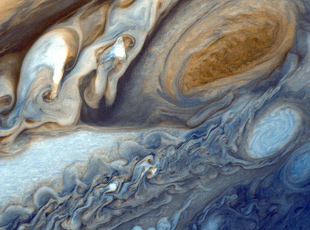
Photography of Jupiter began in January 1979, when images of the brightly banded planet already exceeded the best taken from Earth. Voyager 1 completed its Jupiter encounter in early April, after taking almost 19,000 pictures and many other scientific measurements. Voyager 2 picked up the baton in late April and its encounter continued into August. They took more than 33,000 pictures of Jupiter and its five major satellites.
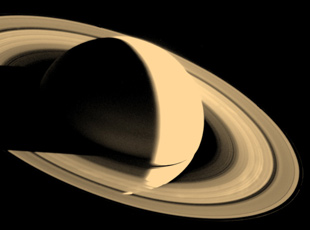
The Voyager 1 and 2 Saturn encounters occurred nine months apart, in November 1980 and August 1981. Voyager 1 is leaving the solar system. Voyager 2 completed its encounter with Uranus in January 1986 and with Neptune in August 1989, and is now also en route out of the solar system.
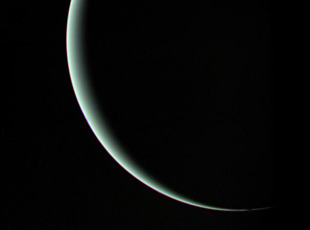
NASA's Voyager 2 spacecraft flew closely past distant Uranus, the seventh planet from the Sun, in January. At its closet, the spacecraft came within 81,800 kilometers (50,600 miles) of Uranus's cloudtops on Jan. 24, 1986. Voyager 2 radioed thousands of images and voluminous amounts of other scientific data on the planet, its moons, rings, atmosphere, interior and the magnetic environment surrounding Uranus.
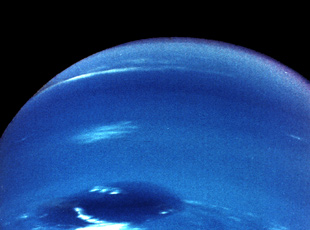
In the summer of 1989, NASA's Voyager 2 became the first spacecraft to observe the planet Neptune, its final planetary target. Passing about 4,950 kilometers (3,000 miles) above Neptune's north pole, Voyager 2 made its closest approach to any planet since leaving Earth 12 years ago. Five hours later, Voyager 2 passed about 40,000 kilometers (25,000 miles) from Neptune's largest moon, Triton, the last solid body the spacecraft will have an opportunity to study.
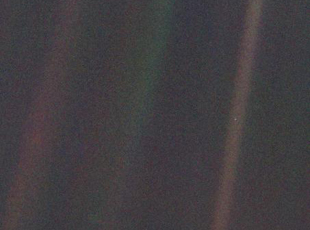
This narrow-angle color image of the Earth, dubbed 'Pale Blue Dot', is a part of the first ever 'portrait' of the solar system taken by Voyager 1. The spacecraft acquired a total of 60 frames for a mosaic of the solar system from a distance of more than 4 billion miles from Earth and about 32 degrees above the ecliptic. From Voyager's great distance Earth is a mere point of light, less than the size of a picture element even in the narrow-angle camera. Earth was a crescent only 0.12 pixel in size. Coincidentally, Earth lies right in the center of one of the scattered light rays resulting from taking the image so close to the sun. This blown-up image of the Earth was taken through three color filters -- violet, blue and green -- and recombined to produce the color image. The background features in the image are artifacts resulting from the magnification.
- Become A Member
- Gift Membership
- Kids Membership
- Other Ways to Give
- Explore Worlds
- Defend Earth
How We Work
- Education & Public Outreach
- Space Policy & Advocacy
- Science & Technology
- Global Collaboration
Our Results
Learn how our members and community are changing the worlds.
Our citizen-funded spacecraft successfully demonstrated solar sailing for CubeSats.
Space Topics
- Planets & Other Worlds
- Space Missions
- Space Policy
- Planetary Radio
- Space Images
The Planetary Report
The eclipse issue.
Science and splendor under the shadow.
Get Involved
Membership programs for explorers of all ages.
Get updates and weekly tools to learn, share, and advocate for space exploration.
Volunteer as a space advocate.
Support Our Mission
- Renew Membership
- Society Projects
The Planetary Fund
Accelerate progress in our three core enterprises — Explore Worlds, Find Life, and Defend Earth. You can support the entire fund, or designate a core enterprise of your choice.
- Strategic Framework
- News & Press
The Planetary Society
Know the cosmos and our place within it.
Our Mission
Empowering the world's citizens to advance space science and exploration.
- Explore Space
- Take Action
- Member Community
- Account Center
- “Exploration is in our nature.” - Carl Sagan
Rae Paoletta • Mar 03, 2022
The best space pictures from the Voyager 1 and 2 missions
Launched in 1977, NASA’s Voyager 1 and 2 missions provided an unprecedented glimpse into the outer solar system — a liminal space once left largely to the imagination. The spacecraft provided views of worlds we’d never seen before, and in some cases, haven’t seen much of since.
The Voyager probes were launched about two weeks apart and had different trajectories, like two tour guides at the same museum. Only Voyager 2 visited the ice giants — Uranus and Neptune — for example.
The Voyagers hold a unique position in the pantheon of space history because they’re still making it; even right now, Voyagers 1 and 2 are the only functioning spacecraft in interstellar space. Both hold a Golden Record that contains sights and sounds of Earth in case alien life were to find one of the spacecraft.
As the Voyager missions voyage on, it’s good to look back at how they captured our solar system before leaving it.
This content is hosted by a third party (youtube.com), which uses marketing cookies. Please accept marketing cookies to watch this video.
Let’s Go Beyond The Horizon
Every success in space exploration is the result of the community of space enthusiasts, like you, who believe it is important. You can help usher in the next great era of space exploration with your gift today.
For full functionality of this site it is necessary to enable JavaScript. Here are instructions on how to enable JavaScript in your web browser .
Voyager 1 Spacecraft's Road to Interstellar Space: A Photo Timeline
Nasa's voyager 1 spacecraft.
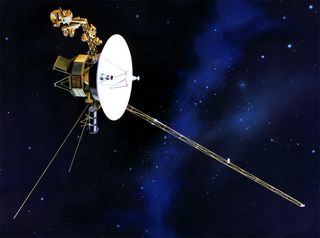
NASA's Voyager 1 spacecraft launched in 1977 and reached interstellar space 35 years later. Take a look at Voyager 1's bold journey into a new space frontier with this SPACE.com timeline. [ See SPACE.com's Compete Coverage: Voyager 1 In Interstellar Space ]
Sept. 5, 1977: Voyager 1 Launch
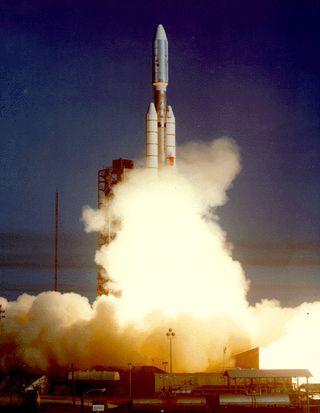
This photo shows NASA's Voyager 2's launch on Aug. 20, 1977. Voyager 1 launched on Sept. 5 of the same year. [ See SPACE.com's Compete Coverage: Voyager 1 In Interstellar Space ]
Sept. 5, 1977: Voyager 1 Snaps Photo of Earth and Moon
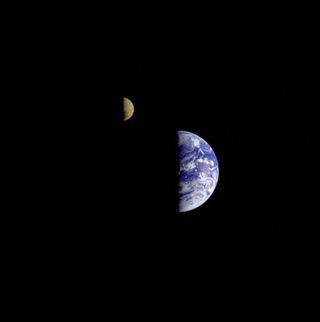
This image of the Earth and moon in a single frame, the first of its kind ever taken by a spacecraft, was recorded on Sept. 18, 1977, by Voyager 1 when it was 7.25 million miles from Earth. The moon is at the top of the picture and beyond the Earth as viewed by Voyager. [ See SPACE.com's Compete Coverage: Voyager 1 In Interstellar Space ]
March 5, 1979: Voyager 1 Makes Jupiter Flyby
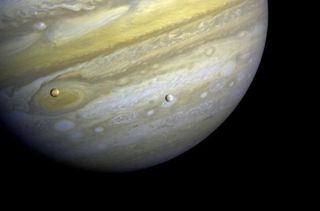
Voyager 1 took photos of Jupiter and two of its satellites (Io, left, and Europa). The new study says that moons orbiting a gas giant planet greater than 8 Jupiter masses could help astronomers detect a rogue planet. [ See SPACE.com's Compete Coverage: Voyager 1 In Interstellar Space ]
Nov. 12, 1980: Voyager 1 Flies By Saturn

NASA's Voyager 1 spacecraft revealed the kinks in one of Saturn's narrowest rings. The Voyager 1 image (left) was released on Nov. 12, 1980. The closer view of the F ring (right) was obtained by NASA's Cassini spacecraft on April 13, 2005. The moon Pandora is to the left (exterior) of the ring and the moon Prometheus is to the right (interior) of the ring. [ See SPACE.com's Compete Coverage: Voyager 1 In Interstellar Space ]
1982: NASA Upgrades Deep Space Network Antennas
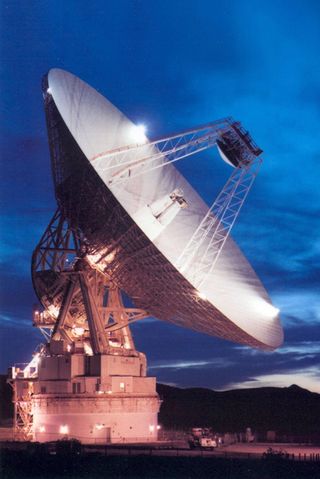
In 1982, NASA upgraded its Deep Space Network of antennas which it uses to control and receive messages from Voyager 1 and its twin Voyager 2. [ See SPACE.com's Compete Coverage: Voyager 1 In Interstellar Space ]
Jan. 1, 1990: Voyager Begins Extended' Interstellar Mission '
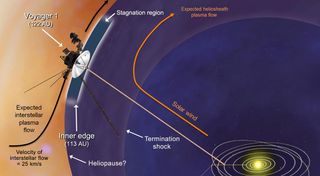
This artist's concept shows plasma flows around NASA's Voyager 1 spacecraft as it gets close to entering interstellar space. The orange arrow shows the direction of the solar wind. Image released Dec. 3, 2012. [ See SPACE.com's Compete Coverage: Voyager 1 In Interstellar Space ]
Get the Space.com Newsletter
Breaking space news, the latest updates on rocket launches, skywatching events and more!
Feb. 14, 1990: Voyager Takes Final Solar System Portrait
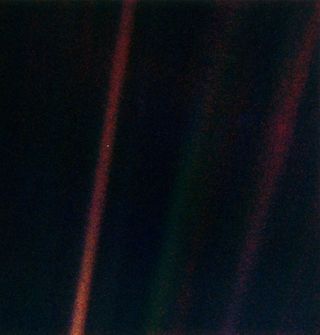
This narrow-angle color image of the Earth s a part of the first ever "portrait" of the solar system taken by Voyager 1. The spacecraft acquired a total of 60 frames for a mosaic of the solar system from a distance of more than 4 billion miles from Earth and about 32 degrees above the ecliptic. Image released Feb. 14, 1990. [ See SPACE.com's Compete Coverage: Voyager 1 In Interstellar Space ]
Feb. 17, 1998: Voyager 1 passes Pioneer 10

On Feb. 17, 1998, Voyager 1 became the farthest manmade object in space when it passed Pioneer 10 on the way out of the solar system. [ See SPACE.com's Compete Coverage: Voyager 1 In Interstellar Space ]
Voyager Signal Spotted By Earth Radio Telescopes

In 1990, Voyager 1 took the famous "Pale Blue Dot" picture looking back at Earth. In 2013, the Very Long Baseline Array got the reverse-angle shot — this radio telescope image showing the signal of the spacecraft as a similar point of light. Image released Sept. 12, 2013. [ See SPACE.com's Compete Coverage: Voyager 1 In Interstellar Space ]
August 2012: Voyager Enters Interstellar Space

This artist's concept depicts NASA's Voyager 1 spacecraft entering interstellar space, or the space between stars. Interstellar space is dominated by the plasma, or ionized gas, that was ejected by the death of nearby giant stars millions of years ago. The environment inside our solar bubble is dominated by the plasma exhausted by our sun, known as the solar wind. The interstellar plasma is shown with an orange glow similar to the color seen in visible-light images from NASA's Hubble Space Telescope that show stars in the Orion nebula traveling through interstellar space. Image released Sept. 12, 2013. [ See SPACE.com's Compete Coverage: Voyager 1 In Interstellar Space ]
Join our Space Forums to keep talking space on the latest missions, night sky and more! And if you have a news tip, correction or comment, let us know at: [email protected].
Current page: Page 1

Tariq is the Editor-in-Chief of Space.com and joined the team in 2001, first as an intern and staff writer, and later as an editor. He covers human spaceflight, exploration and space science, as well as skywatching and entertainment. He became Space.com's Managing Editor in 2009 and Editor-in-Chief in 2019. Before joining Space.com, Tariq was a staff reporter for The Los Angeles Times covering education and city beats in La Habra, Fullerton and Huntington Beach. In October 2022, Tariq received the Harry Kolcum Award for excellence in space reporting from the National Space Club Florida Committee. He is also an Eagle Scout (yes, he has the Space Exploration merit badge) and went to Space Camp four times as a kid and a fifth time as an adult. He has journalism degrees from the University of Southern California and New York University. You can find Tariq at Space.com and as the co-host to the This Week In Space podcast with space historian Rod Pyle on the TWiT network . To see his latest project, you can follow Tariq on Twitter @tariqjmalik .
Boeing's Starliner spacecraft is 'go' for May 6 astronaut launch
Building rockets and looking for life on Venus: Q&A with Rocket Lab's Peter Beck
SpaceX launching Falcon 9 rocket on record-tying 20th mission today
Most Popular
- 2 Watch 2 gorgeous supernova remnants evolve over 20 years (timelapse video)
- 3 Boeing Starliner 1st astronaut flight: Live updates
- 4 US Space Force picks Rocket Lab for 2025 Victus Haze space domain awareness mission
- 5 Exploding stars send out powerful bursts of energy − I'm leading a citizen scientist project to classify and learn about these bright flashes
Voyager, 11 Billion Miles Later: Photos from the Depths of Our Solar System
For 33 years, America's Voyager spacecraft have been flying toward the edges of our solar system. TIME surveys the most notable interstellar scenes captured by the Voyager's cameras along the way.
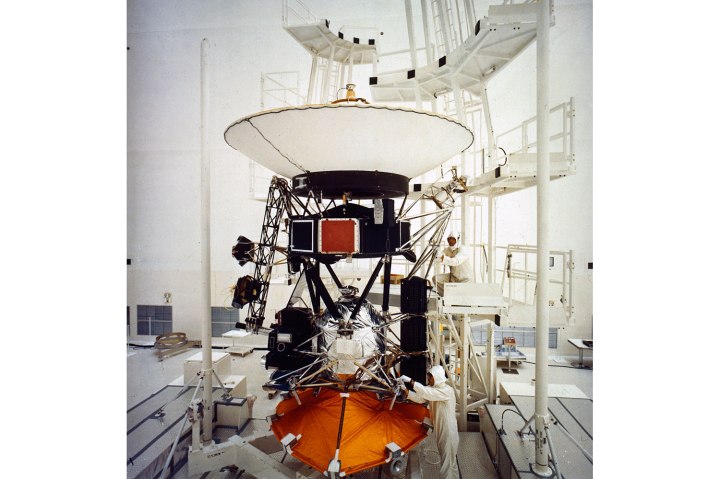
A technician checks a test model of a Voyager spacecraft at the SAEF-1 facility at the Kennedy Space Centre, Cape Canaveral, Fla. Two Voyager spacecraft were launched in 1977 to explore the planets in the outer Solar System and both were successful, returning many high quality pictures as well as scientific data.

For 33 years, America’s Voyager spacecraft have been flying toward the edges of our solar system. TIME surveys the most notable interstellar scenes captured by the Voyager’s cameras along the way.
PHOTOS: Window on Infinity: Pictures from Space
MORE: Voyager 1 at the Threshold of Forever
More Photography from Time
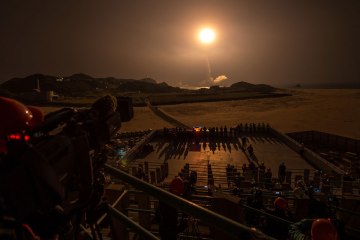
- The Inventory
Support Quartz
Fund next-gen business journalism with $10 a month
Free Newsletters
Let’s take a moment to look at the mesmerizing images from Voyager 1
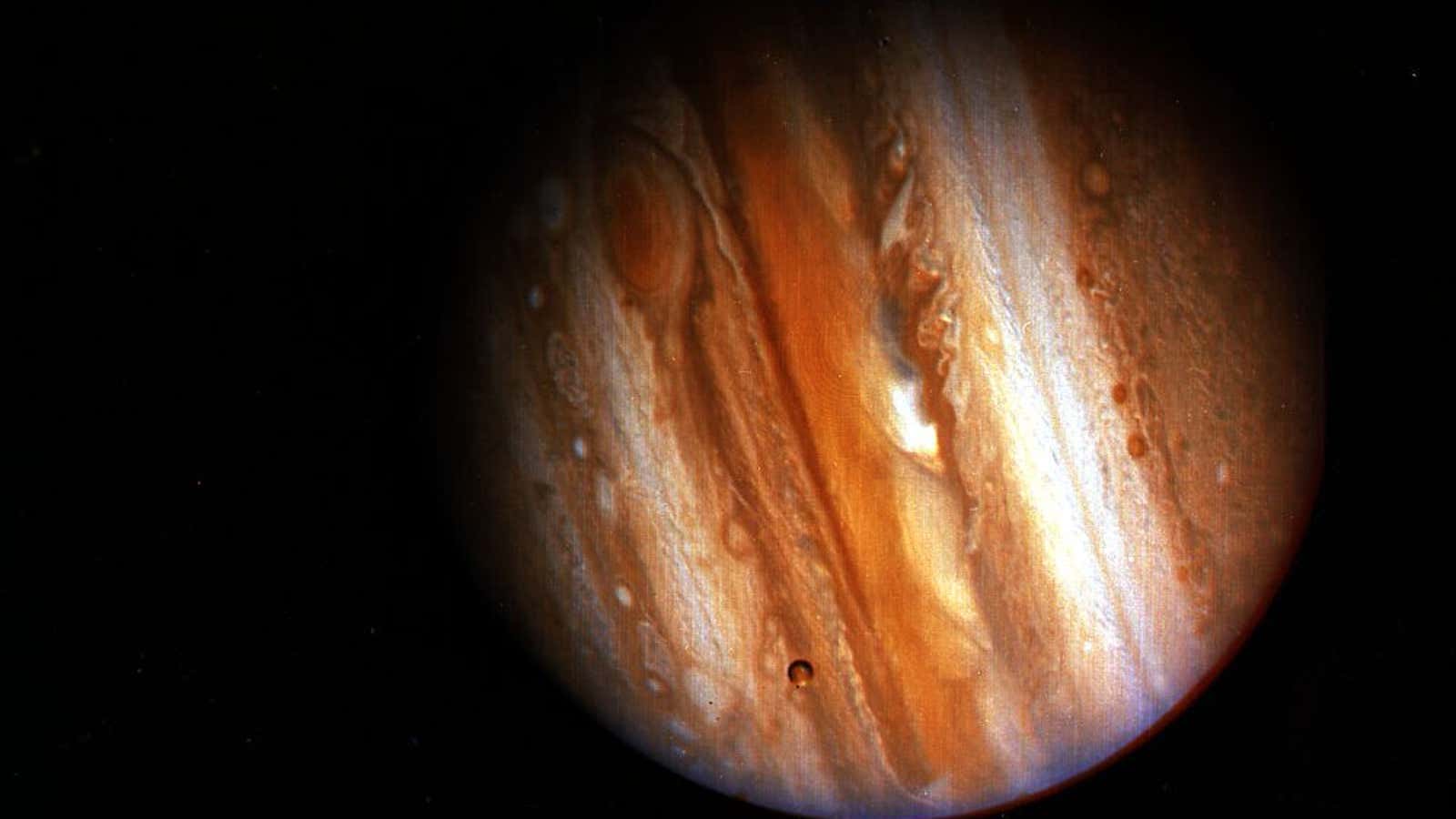
In 1977, NASA launched two Voyager probes, equipped with golden records describing human accomplishment, on a mission to explore the farthest reaches of the solar system. Each record catalogued our music, our greetings, our art and photography.
Forty years later, both spacecrafts are still hurtling through space , exploring parts of the universe where nothing from Earth has visited before. Voyager 1 is now in interstellar space, 13 billion miles away from Earth. Voyager 2 is passing through the heliosheath, the outermost layer of the heliosphere, before it, too, reaches interstellar space.
Last week, in an amazing feat of engineering, NASA engineers turned on Voyager 1’s backup thrusters after they’d been dormant for 37 years. The thrusters will help reorient the spacecraft’s antenna back to Earth, so we can receive its signal for just a little longer.
It’s a fine moment to reflect on the incredible images Voyager 1 has sent back over its lifetime. The probe gave us the first “ portrait ” of our solar system, and memorably mesmerizing shots of Saturn and Jupiter.
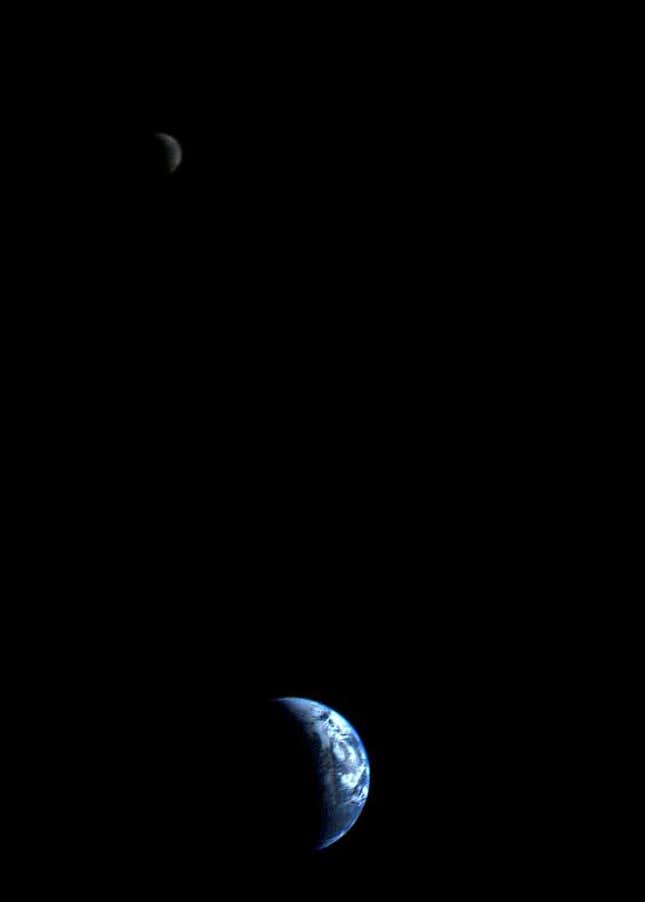
Watch NASA’s moving compilation of images from both Voyagers below:
📬 Sign up for the Daily Brief
Our free, fast, and fun briefing on the global economy, delivered every weekday morning.
NASA Hears From Voyager 1, the Most Distant Spacecraft From Earth, After Months of Quiet
NASA has finally heard back from Voyager 1 in a way that makes sense

This illustration provided by NASA depicts Voyager 1. The most distant spacecraft from Earth stopped sending back understandable data in November 2023. Flight controllers traced the blank communication to a bad computer chip and rearranged the spacecraft’s coding to work around the trouble. In mid-April 2024, NASA’s Jet Propulsion Laboratory declared success after receiving good engineering updates. The team is still working to restore transmission of the science data. (NASA via AP)
CAPE CANAVERAL, Fla. (AP) — NASA has finally heard back from Voyager 1 again in a way that makes sense.
The most distant spacecraft from Earth stopped sending back understandable data last November. Flight controllers traced the blank communication to a bad computer chip and rearranged the spacecraft’s coding to work around the trouble.
NASA’s Jet Propulsion Laboratory in Southern California declared success after receiving good engineering updates late last week. The team is still working to restore transmission of the science data.
It takes 22 1/2 hours to send a signal to Voyager 1, more than 15 billion miles (24 billion kilometers) away in interstellar space. The signal travel time is double that for a round trip.
Contact was never lost, rather it was like making a phone call where you can’t hear the person on the other end, a JPL spokeswoman said Tuesday.
Launched in 1977 to study Jupiter and Saturn, Voyager 1 has been exploring interstellar space — the space between star systems — since 2012. Its twin, Voyager 2, is 12.6 billion miles (20 billion kilometers) away and still working fine.
Photos You Should See - April 2024

The Associated Press Health and Science Department receives support from the Howard Hughes Medical Institute’s Science and Educational Media Group. The AP is solely responsible for all content.
Copyright 2024 The Associated Press . All rights reserved. This material may not be published, broadcast, rewritten or redistributed.
Join the Conversation
Tags: Associated Press , science
America 2024

Health News Bulletin
Stay informed on the latest news on health and COVID-19 from the editors at U.S. News & World Report.
Sign in to manage your newsletters »
Sign up to receive the latest updates from U.S News & World Report and our trusted partners and sponsors. By clicking submit, you are agreeing to our Terms and Conditions & Privacy Policy .
You May Also Like
The 10 worst presidents.
U.S. News Staff Feb. 23, 2024

Cartoons on President Donald Trump
Feb. 1, 2017, at 1:24 p.m.

Photos: Obama Behind the Scenes
April 8, 2022

Photos: Who Supports Joe Biden?
March 11, 2020

RFK Jr.: By the Numbers
Laura Mannweiler April 26, 2024

Biden’s Student Loan Chief to Step Down
Lauren Camera April 26, 2024

What to Know: Bird Flu Virus in Milk
Cecelia Smith-Schoenwalder April 26, 2024


Inflation a Stubborn Foe for the Fed
Tim Smart April 26, 2024

The Curse of the Modern Vice President

‘A Rule for the Ages’
Lauren Camera April 25, 2024

- Mobile Site
- Staff Directory
- Advertise with Ars
Filter by topic
- Biz & IT
- Gaming & Culture
Front page layout
22.5 light hours —
Recoding voyager 1—nasa’s interstellar explorer is finally making sense again, "we're pretty much seeing everything we had hoped for, and that's always good news.”.
Stephen Clark - Apr 23, 2024 5:56 pm UTC
Engineers have partially restored a 1970s-era computer on NASA's Voyager 1 spacecraft after five months of long-distance troubleshooting, building confidence that humanity's first interstellar probe can eventually resume normal operations.
Several dozen scientists and engineers gathered Saturday in a conference room at NASA's Jet Propulsion Laboratory, or connected virtually, to wait for a new signal from Voyager 1. The ground team sent a command up to Voyager 1 on Thursday to recode part of the memory of the spacecraft's Flight Data Subsystem (FDS) , one of the probe's three computers.
“In the minutes leading up to when we were going to see a signal, you could have heard a pin drop in the room," said Linda Spilker, project scientist for NASA's two Voyager spacecraft at JPL. "It was quiet. People were looking very serious. They were looking at their computer screens. Each of the subsystem (engineers) had pages up that they were looking at, to watch as they would be populated."
Finally, a breakthrough
Launched nearly 47 years ago, Voyager 1 is flying on an outbound trajectory more than 15 billion miles (24 billion kilometers) from Earth, and it takes 22-and-a-half hours for a radio signal to cover that distance at the speed of light. This means it takes nearly two days for engineers to uplink a command to Voyager 1 and get a response.
In November, Voyager 1 suddenly stopped transmitting its usual stream of data containing information about the spacecraft's health and measurements from its scientific instruments. Instead, the spacecraft's data stream was entirely unintelligible. Because the telemetry was unreadable, experts on the ground could not easily tell what went wrong. They hypothesized the source of the problem might be in the memory bank of the FDS.
There was a breakthrough last month when engineers sent up a novel command to "poke" Voyager 1's FDS to send back a readout of its memory. This readout allowed engineers to pinpoint the location of the problem in the FDS memory . The FDS is responsible for packaging engineering and scientific data for transmission to Earth.
After a few weeks, NASA was ready to uplink a solution to get the FDS to resume packing engineering data. This data stream includes information on the status of the spacecraft—things like power levels and temperature measurements. This command went up to Voyager 1 through one of NASA's large Deep Space Network antennas Thursday.
Then, the wait for a response. Spilker, who started working on Voyager right out of college in 1977, was in the room when Voyager 1's signal reached Earth Saturday.
"When the time came to get the signal, we could clearly see all of a sudden, boom, we had data, and there were tears and smiles and high fives," she told Ars. "Everyone was very happy and very excited to see that, hey, we're back in communication again with Voyager 1. We're going to see the status of the spacecraft, the health of the spacecraft, for the first time in five months."

Throughout the five months of troubleshooting, Voyager's ground team continued to receive signals indicating the spacecraft was still alive. But until Saturday, they lacked insight into specific details about the status of Voyager 1.
“It’s pretty much just the way we left it," Spilker said. "We're still in the initial phases of analyzing all of the channels and looking at their trends. Some of the temperatures went down a little bit with this period of time that's gone on, but we're pretty much seeing everything we had hoped for. And that's always good news.”
Relocating code
Through their investigation, Voyager's ground team discovered a single chip responsible for storing a portion of the FDS memory stopped working, probably due to either a cosmic ray hit or a failure of aging hardware. This affected some of the computer's software code.
"That took out a section of memory," Spilker said. "What they have to do is relocate that code into a different portion of the memory, and then make sure that anything that uses those codes, those subroutines, know to go to the new location of memory, for access and to run it."
Only about 3 percent of the FDS memory was corrupted by the bad chip, so engineers needed to transplant that code into another part of the memory bank. But no single location is large enough to hold the section of code in its entirety, NASA said.
So the Voyager team divided the code into sections for storage in different places in the FDS. This wasn't just a copy-and-paste job. Engineers needed to modify some of the code to make sure it will all work together. "Any references to the location of that code in other parts of the FDS memory needed to be updated as well," NASA said in a statement.
reader comments
Channel ars technica.
- Environment
- Road to Net Zero
- Art & Design
- Film & TV
- Music & On-stage
- Pop Culture
- Fashion & Beauty
- Home & Garden
- Things to do
- Combat Sports
- Horse Racing
- Beyond the Headlines
- Trending Middle East
- Business Extra
- Culture Bites
- Year of Elections
- Pocketful of Dirhams
- Books of My Life
- Iraq: 20 Years On
Signal from interstellar space: What Voyager 1's latest data tells us
Engineers hear from the longest-operating spacecraft for the first time in five months.
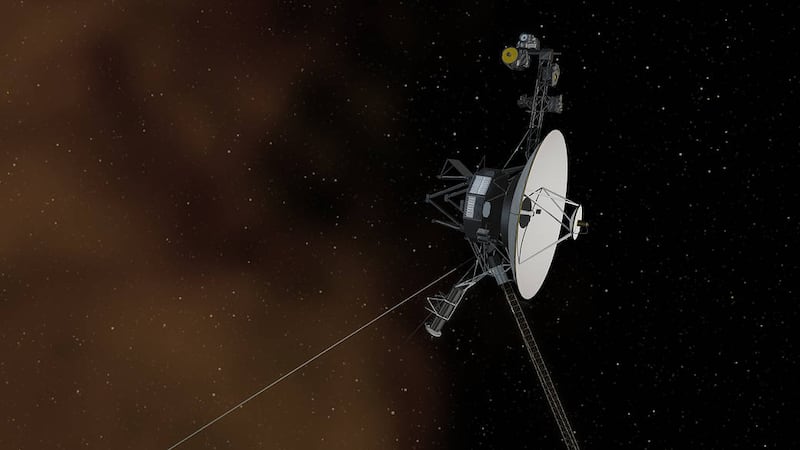
An artist's impression of the Voyager 1 spacecraft entering interstellar space. Photo: Nasa

Scientists are hopeful of collecting fresh data from the Voyager 1 deep space probe after it beamed back its first signals in five months.
The pioneering craft, which launched in 1977, was the first to enter interstellar space , the region beyond the solar system.
But Nasa engineers at mission control in California lost contact with it on November 14 due to a fault with one of its three on-board computers.
The technical issue caused Voyager 1 to send indecipherable messages for months, rendering the engineering and scientific data unusable.
Sounding a little more like yourself, #Voyager1 . For the first time since November, Voyager 1 is returning useable data about the health and status of its onboard engineering systems. Next step: Enable the spacecraft to begin returning science data again: https://t.co/eZyqo7uERu pic.twitter.com/6YZM33Mp48 — NASA JPL (@NASAJPL) April 22, 2024
But now, after receiving readable signals from the craft, engineers at the Jet Propulsion Laboratory (JPL) believe they may be able to recover the data entirely so that scientific operations can resume.
"For the first time since November, Nasa’s Voyager 1 spacecraft is returning usable data about the health and status of its on-board engineering systems," JPL said in a statement.
Voyager 1 has travelled 24 billion km since it was launched, making it and its twin Voyager 2 the two longest-serving spacecraft in history.
What do Voyager 1's latest signals mean?
The problem occurred in the flight data subsystem (FDS), which is responsible for packing the science and engineering data before it is sent back to mission control.
But the chip that stores the memory from the subsystem, including some of its software code, was not working.
Because that code was lost, it caused the spacecraft to send back unreadable data.
Last month, engineers came up with a plan to divide the affected code into sections and store these separately in the FDS.
The plan worked and Voyager 1 sent readable signals for the first time in five months.
Resuming operations
"During the coming weeks, the team will relocate and adjust the other affected portions of the FDS software," JPL said.
"These include the portions that will start returning science data."
Scientists are interested in learning about interstellar space to better understand the universe and possibilities of life beyond Earth.
Nasa has been studying exoplanets – those outside the solar system – for decades, using telescopes.
But no spacecraft has entered interstellar space apart from the Voyager probes.
The spacecraft are providing direct measurements of the mysterious environment, which should help the scientific community study cosmic rays and radiation levels outside the solar system.
Data as such could prove useful when technology is advanced enough to send more spacecraft or even a human mission to interstellar space.
While it was an incredible achievement by the Voyager probes, still no technology can reach our nearest star, Proxima Centauri, which is 4.2 light years away.
With power supplies weakening, it is impossible for Voyager 1 to reach Proxima Centauri, which would take the probe almost 73,000 years.
Nuclear fusion propulsion, a way of powering a spacecraft using high-energy particles created by fusion reactions, could help in making such missions more time-efficient and therefore possible.
America's new space race with China: in pictures
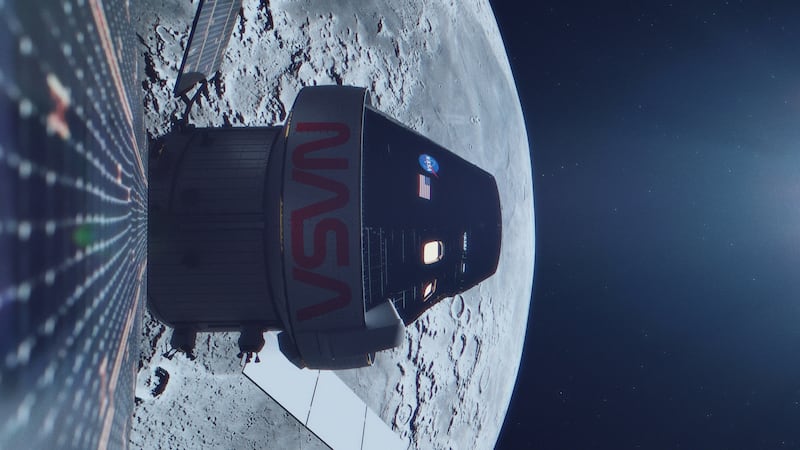
Nasa's Orion spacecraft will carry astronauts to the Moon. It orbited the lunar surface in 2022 as part of an uncrewed test flight. Nasa

Subscribe or renew today
Every print subscription comes with full digital access
Science News
‘humanity’s spacecraft’ voyager 1 is back online and still exploring.
After five months of glitching, the spacecraft is talking to Earth again from interstellar space

The Voyager 1 spacecraft (illustrated) is back online after a few months of transmitting garbled data. It’s now poised to continue its exploration of interstellar space.
JPL-Caltech/NASA
Share this:
By Ramin Skibba
April 26, 2024 at 11:45 am
After months of challenging trouble-shooting and suspenseful waiting, Voyager 1 is once again talking to Earth.
The aging NASA spacecraft, about 24 billion kilometers from home, began transmitting garbled data in November. On April 20, NASA scientists got the probe back online after uploading new flight software to work around a chunk of onboard computer memory that had failed. They’re now receiving data about the spacecraft’s health and hope to hear from its science instruments again in a few weeks, says Suzanne Dodd, the mission’s project manager at NASA’s Jet Propulsion Laboratory in Pasadena, Calif.
That means the iconic craft could be on a path to recovery — and to continue its exploration of interstellar space.
Launched in 1977, Voyager 1 briefly visited Jupiter and Saturn before eventually departing the solar system. It and its twin, Voyager 2, are the longest-operating space probes, now tasked with studying far-flung solar particles and cosmic rays. In particular, the probes have been monitoring the changing of the sun’s magnetic field and the density of plasma beyond the solar system, yielding information about the farthest reaches of the sun’s influence .
“The spacecraft is really remarkable in its longevity. It’s incredible,” Dodd says. “We want to keep Voyager going as long as possible so we have this time record of these changes.”
Voyager 1 and 2, cruising along diverging paths, made history by crossing the heliopause in 2012 and 2018 , respectively ( SN: 9/12/13; SN: 12/10/18 ). At nearly 18 billion kilometers from the sun, that’s long been considered the outer extent of our star’s magnetic field and the solar wind, the boundary before interstellar space.
Since then, Dodd says, the science team has made some surprising findings ( SN: 11/4/19 ). For one, they’ve determined that the heliosphere, the huge bubble of space dominated by the solar wind, might not be spherical but have one or two tails, making it shaped like a comet or a croissant.
And thanks to Voyager, scientists now know that, despite expectations otherwise, the sun’s magnetic field and charged particles actually remain significant even beyond the heliopause, says David McComas, a Princeton University astrophysicist not involved in the mission.
Some theories predicted a serene environment in the distant oceans of interstellar space, but the Voyagers keep passing through waves of charged particles, indicating that the solar magnetic field still holds some sway there. What’s more, the probes’ data have shown how ripples in the field form bubbles at the edge of the solar system, which is more frothy and dynamic than expected.
Other missions have begun building on Voyager’s solar physics research. These include NASA’s Interstellar Boundary Explorer, or IBEX, and the Interstellar Mapping and Acceleration Probe, or IMAP, which is set to launch next year. Earth-orbiting IBEX has been measuring high-energy particles to map the heliosphere for 15 years, whereas IMAP will orbit between the sun and Earth, giving it an uninterrupted view of the sun as it monitors the galactic cosmic rays that manage to filter through the heliosphere.
“There’s a huge synergy between the Voyagers and both IBEX and IMAP,” says McComas, principal investigator of the latter two missions. “We were all really scared when Voyager 1 stopped phoning home.”
It will be decades until another mission could accomplish what the Voyagers have done. NASA’s New Horizons soared by Pluto in 2015 and kept going ( SN:8/9/18 ). It’s heading toward the edge of the solar system, but it’s cruising slowly and will run out of power before it can collect data beyond the heliopause.
The Voyagers can fly forever, but power for their instruments is waning. Over the next few years, NASA will shut some down to conserve energy for the rest.
That means Voyager 1’s days of collecting science data are numbered. “It’s a very beloved mission,” Dodd says. “It’s humanity’s spacecraft, and we need to take care of it.”
More Stories from Science News on Space

Separating science fact from fiction in Netflix’s ‘3 Body Problem’

Pluto’s heart-shaped basin might not hide an ocean after all

Our picture of habitability on Europa, a top contender for hosting life, is changing

Jupiter’s moon Io may have been volcanically active ever since it was born

50 years ago, scientists found a lunar rock nearly as old as the moon

How a sugar acid crucial for life could have formed in interstellar clouds

What Science News saw during the solar eclipse

During the awe of totality, scientists studied our planet’s reactions
Subscribers, enter your e-mail address for full access to the Science News archives and digital editions.
Not a subscriber? Become one now .
After months of sending gibberish to NASA, Voyager 1 is finally making sense again
NASA's Voyager 1 probe has resumed sending usable data back to Earth after engineers fixed a computer error that caused the interstellar spacecraft to only transmit gibberish for five months.
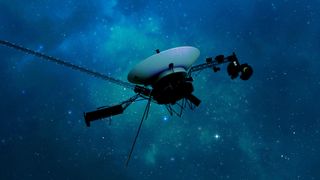
NASA's Voyager 1 probe is once again sending readable radio signals back to Earth after engineers fixed a computer glitch that caused the spacecraft to malfunction in November .
For the first time in five months, Voyager 1 is now transmitting usable data about the health and status of its onboard engineering systems back to our planet, NASA's Jet Propulsion Laboratory announced Monday (April 22). However, engineers have yet to fix the software that enables the spacecraft to return science data.
Voyager 1 is cruising through interstellar space roughly 15 billion miles (24 billion kilometers) away from Earth, which means mission control teams have to wait 22.5 hours for their commands to reach the spacecraft and another 22.5 hours for a response. Voyager 1 and its twin probe — Voyager 2, which continues to operate normally after a 2-week blackout last year — were launched almost 47 years ago and are the most distant human-made objects in existence.
Engineers first noticed something wrong with Voyager 1 on Nov. 14, 2023, when the probe suddenly began transmitting a nonsensical stream of ones and zeros instead of its usual neatly packaged science and engineering datasets.
Mission controllers could tell the spacecraft was still receiving their commands, however, indicating that its vital systems were operating normally.
Related: A mysterious 'hum' vibrates interstellar space. Voyager 1 has a recording of it.
In early March, after three months of unsuccessful tinkering , NASA engineering teams determined the issue was tied to one of Voyager 1's three onboard computer systems known as the "flight data subsystem" (FDS). The FDS is essential for packaging data harvested by the probe before they are sent to Earth, according to NASA's announcement.
Sign up for the Live Science daily newsletter now
Get the world’s most fascinating discoveries delivered straight to your inbox.
Engineers located the glitch by sending a command — or "poke" — that prompted the FDS to try new sequences of code in its software in case the issue could be resolved by skirting a corrupted section. The command triggered a signal that differed from the stream of gibberish the spacecraft had been sending back, and that engineers were able to decode .

It turned out a single chip responsible for storing a portion of the FDS memory, including some of its computer software code, had stopped working. The loss of that code meant the probe's science and engineering data were unusable, according to NASA. To get around the issue, engineers broke up the code once stored in the chip and squeezed sections of it into functioning portions of the FDS memory.
— Historic space photo of the week: Voyager 2 spies a storm on Saturn 42 years ago
— Neptune isn't as blue as you think, and these new images of the planet prove it
— Uranus and Neptune aren't made of what we thought, new study hints
The team then rewrote some of the reshuffled code so it could work as a whole again.
Engineers saved these modifications to the FDS memory on April 18. Two days later, they received a response from Voyager 1 showing that the reshuffle worked. For the first time in five months, the probe's message contained readable data, prompting celebrations at the Jet Propulsion Laboratory in Southern California.
However, solving the spacecraft's science data transmission will take further mending of the corrupted portions of the FDS software, NASA said in its announcement.

Sascha is a U.K.-based trainee staff writer at Live Science. She holds a bachelor’s degree in biology from the University of Southampton in England and a master’s degree in science communication from Imperial College London. Her work has appeared in The Guardian and the health website Zoe. Besides writing, she enjoys playing tennis, bread-making and browsing second-hand shops for hidden gems.
Dying SpaceX rocket tears blood-red 'hole' in the sky over Texas — again
NASA's downed Ingenuity helicopter has a 'last gift' for humanity — but we'll have to go to Mars to get it
How common chemicals — including those in bed sheets — can boost eczema risk
admin said: NASA engineers have fixed a computer error that caused the interstellar Voyager 1 probe to glitch and stop transmitting data back to Earth for five months. After months of sending gibberish to NASA, Voyager 1 is finally making sense again : Read more
- View All 1 Comment
Most Popular
- 2 James Webb telescope confirms there is something seriously wrong with our understanding of the universe
- 3 Eclipse from space: Paths of 2024 and 2017 eclipses collide over US in new satellite image
- 4 How common chemicals — including those in bed sheets — can boost eczema risk
- 5 Scientists discover once-in-a-billion-year event — 2 lifeforms merging to create a new cell part
- 2 'Octagonal' sword from Bronze Age burial in Germany is so well preserved it shines
- 3 Haunting photo of Earth and moon snapped by China's experimental lunar satellites
- 4 Tweak to Schrödinger's cat equation could unite Einstein's relativity and quantum mechanics, study hints
- 5 Can humans see ultraviolet light?
- Share full article
Advertisement
Supported by
Voyager 1, First Craft in Interstellar Space, May Have Gone Dark
The 46-year-old probe, which flew by Jupiter and Saturn in its youth and inspired earthlings with images of the planet as a “Pale Blue Dot,” hasn’t sent usable data from interstellar space in months.

By Orlando Mayorquin
When Voyager 1 launched in 1977, scientists hoped it could do what it was built to do and take up-close images of Jupiter and Saturn. It did that — and much more.
Voyager 1 discovered active volcanoes, moons and planetary rings, proving along the way that Earth and all of humanity could be squished into a single pixel in a photograph, a “ pale blue dot, ” as the astronomer Carl Sagan called it. It stretched a four-year mission into the present day, embarking on the deepest journey ever into space.
Now, it may have bid its final farewell to that faraway dot.
Voyager 1 , the farthest man-made object in space, hasn’t sent coherent data to Earth since November. NASA has been trying to diagnose what the Voyager mission’s project manager, Suzanne Dodd, called the “most serious issue” the robotic probe has faced since she took the job in 2010.
The spacecraft encountered a glitch in one of its computers that has eliminated its ability to send engineering and science data back to Earth.
The loss of Voyager 1 would cap decades of scientific breakthroughs and signal the beginning of the end for a mission that has given shape to humanity’s most distant ambition and inspired generations to look to the skies.
“Scientifically, it’s a big loss,” Ms. Dodd said. “I think — emotionally — it’s maybe even a bigger loss.”
Voyager 1 is one half of the Voyager mission. It has a twin spacecraft, Voyager 2.
Launched in 1977, they were primarily built for a four-year trip to Jupiter and Saturn , expanding on earlier flybys by the Pioneer 10 and 11 probes.
The Voyager mission capitalized on a rare alignment of the outer planets — once every 175 years — allowing the probes to visit all four.
Using the gravity of each planet, the Voyager spacecraft could swing onto the next, according to NASA .
The mission to Jupiter and Saturn was a success.
The 1980s flybys yielded several new discoveries, including new insights about the so-called great red spot on Jupiter, the rings around Saturn and the many moons of each planet.
Voyager 2 also explored Uranus and Neptune , becoming in 1989 the only spacecraft to explore all four outer planets.

Voyager 1, meanwhile, had set a course for deep space, using its camera to photograph the planets it was leaving behind along the way. Voyager 2 would later begin its own trek into deep space.
“Anybody who is interested in space is interested in the things Voyager discovered about the outer planets and their moons,” said Kate Howells, the public education specialist at the Planetary Society, an organization co-founded by Dr. Sagan to promote space exploration.
“But I think the pale blue dot was one of those things that was sort of more poetic and touching,” she added.
On Valentine’s Day 1990, Voyager 1, darting 3.7 billion miles away from the sun toward the outer reaches of the solar system, turned around and snapped a photo of Earth that Dr. Sagan and others understood to be a humbling self-portrait of humanity.
“It’s known the world over, and it does connect humanity to the stars,” Ms. Dodd said of the mission.
She added: “I’ve had many, many many people come up to me and say: ‘Wow, I love Voyager. It’s what got me excited about space. It’s what got me thinking about our place here on Earth and what that means.’”
Ms. Howells, 35, counts herself among those people.
About 10 years ago, to celebrate the beginning of her space career, Ms. Howells spent her first paycheck from the Planetary Society to get a Voyager tattoo.
Though spacecraft “all kind of look the same,” she said, more people recognize the tattoo than she anticipated.
“I think that speaks to how famous Voyager is,” she said.
The Voyagers made their mark on popular culture , inspiring a highly intelligent “Voyager 6” in “Star Trek: The Motion Picture” and references on “The X Files” and “The West Wing.”
Even as more advanced probes were launched from Earth, Voyager 1 continued to reliably enrich our understanding of space.
In 2012, it became the first man-made object to exit the heliosphere, the space around the solar system directly influenced by the sun. There is a technical debate among scientists around whether Voyager 1 has actually left the solar system, but, nonetheless, it became interstellar — traversing the space between stars.
That charted a new path for heliophysics, which looks at how the sun influences the space around it. In 2018, Voyager 2 followed its twin between the stars.
Before Voyager 1, scientific data on the sun’s gases and material came only from within the heliosphere’s confines, according to Dr. Jamie Rankin, Voyager’s deputy project scientist.
“And so now we can for the first time kind of connect the inside-out view from the outside-in,” Dr. Rankin said, “That’s a big part of it,” she added. “But the other half is simply that a lot of this material can’t be measured any other way than sending a spacecraft out there.”
Voyager 1 and 2 are the only such spacecraft. Before it went offline, Voyager 1 had been studying an anomalous disturbance in the magnetic field and plasma particles in interstellar space.
“Nothing else is getting launched to go out there,” Ms. Dodd said. “So that’s why we’re spending the time and being careful about trying to recover this spacecraft — because the science is so valuable.”
But recovery means getting under the hood of an aging spacecraft more than 15 billion miles away, equipped with the technology of yesteryear. It takes 45 hours to exchange information with the craft.
It has been repeated over the years that a smartphone has hundreds of thousands of times Voyager 1’s memory — and that the radio transmitter emits as many watts as a refrigerator lightbulb.
“There was one analogy given that is it’s like trying to figure out where your cursor is on your laptop screen when your laptop screen doesn’t work,” Ms. Dodd said.
Her team is still holding out hope, she said, especially as the tantalizing 50th launch anniversary in 2027 approaches. Voyager 1 has survived glitches before, though none as serious.
Voyager 2 is still operational, but aging. It has faced its own technical difficulties too.
NASA had already estimated that the nuclear-powered generators of both spacecrafts would likely die around 2025.
Even if the Voyager interstellar mission is near its end, the voyage still has far to go.
Voyager 1 and its twin, each 40,000 years away from the next closest star, will arguably remain on an indefinite mission.
“If Voyager should sometime in its distant future encounter beings from some other civilization in space, it bears a message,” Dr. Sagan said in a 1980 interview .
Each spacecraft carries a gold-plated phonograph record loaded with an array of sound recordings and images representing humanity’s richness, its diverse cultures and life on Earth.
“A gift across the cosmic ocean from one island of civilization to another,” Dr. Sagan said.
Orlando Mayorquin is a general assignment and breaking news reporter based in New York. More about Orlando Mayorquin
What’s Up in Space and Astronomy
Keep track of things going on in our solar system and all around the universe..
Never miss an eclipse, a meteor shower, a rocket launch or any other 2024 event that’s out of this world with our space and astronomy calendar .
Scientists may have discovered a major flaw in their understanding of dark energy, a mysterious cosmic force . That could be good news for the fate of the universe.
A new set of computer simulations, which take into account the effects of stars moving past our solar system, has effectively made it harder to predict Earth’s future and reconstruct its past.
Dante Lauretta, the planetary scientist who led the OSIRIS-REx mission to retrieve a handful of space dust , discusses his next final frontier.
A nova named T Coronae Borealis lit up the night about 80 years ago. Astronomers say it’s expected to put on another show in the coming months.
Is Pluto a planet? And what is a planet, anyway? Test your knowledge here .
NASA’s Voyager 1 Resumes Sending Engineering Updates to Earth

NASA’s Voyager 1 spacecraft is depicted in this artist’s concept traveling through interstellar space, or the space between stars, which it entered in 2012.
After some inventive sleuthing, the mission team can — for the first time in five months — check the health and status of the most distant human-made object in existence.
For the first time since November , NASA’s Voyager 1 spacecraft is returning usable data about the health and status of its onboard engineering systems. The next step is to enable the spacecraft to begin returning science data again. The probe and its twin, Voyager 2, are the only spacecraft to ever fly in interstellar space (the space between stars).
Voyager 1 stopped sending readable science and engineering data back to Earth on Nov. 14, 2023, even though mission controllers could tell the spacecraft was still receiving their commands and otherwise operating normally. In March, the Voyager engineering team at NASA’s Jet Propulsion Laboratory in Southern California confirmed that the issue was tied to one of the spacecraft’s three onboard computers, called the flight data subsystem (FDS). The FDS is responsible for packaging the science and engineering data before it’s sent to Earth.

After receiving data about the health and status of Voyager 1 for the first time in five months, members of the Voyager flight team celebrate in a conference room at NASA’s Jet Propulsion Laboratory on April 20.
The team discovered that a single chip responsible for storing a portion of the FDS memory — including some of the FDS computer’s software code — isn’t working. The loss of that code rendered the science and engineering data unusable. Unable to repair the chip, the team decided to place the affected code elsewhere in the FDS memory. But no single location is large enough to hold the section of code in its entirety.
So they devised a plan to divide the affected code into sections and store those sections in different places in the FDS. To make this plan work, they also needed to adjust those code sections to ensure, for example, that they all still function as a whole. Any references to the location of that code in other parts of the FDS memory needed to be updated as well.
The team started by singling out the code responsible for packaging the spacecraft’s engineering data. They sent it to its new location in the FDS memory on April 18. A radio signal takes about 22 ½ hours to reach Voyager 1, which is over 15 billion miles (24 billion kilometers) from Earth, and another 22 ½ hours for a signal to come back to Earth. When the mission flight team heard back from the spacecraft on April 20, they saw that the modification worked: For the first time in five months, they have been able to check the health and status of the spacecraft.
Get the Latest News from the Final Frontier
During the coming weeks, the team will relocate and adjust the other affected portions of the FDS software. These include the portions that will start returning science data.
Voyager 2 continues to operate normally. Launched over 46 years ago , the twin Voyager spacecraft are the longest-running and most distant spacecraft in history. Before the start of their interstellar exploration, both probes flew by Saturn and Jupiter, and Voyager 2 flew by Uranus and Neptune.
Caltech in Pasadena, California, manages JPL for NASA.
News Media Contact
Calla Cofield
Jet Propulsion Laboratory, Pasadena, Calif.
626-808-2469
Watch CBS News
Most distant spacecraft from Earth sends data to NASA for first time in 5 months
By Kerry Breen
Updated on: April 23, 2024 / 8:45 PM EDT / CBS News
The most distant spacecraft from Earth has resumed sending data after a five-month gap, NASA said Monday.
NASA's Voyager 1 spacecraft was launched in 1977, about two weeks after the launch of its twin, Voyager 2. The spacecraft has spent over 45 years studying the outer solar system and has made flybys of Jupiter and Saturn and traveled more than 46,000,000,000 miles .
In November 2023, the spacecraft stopped sending "readable science and engineering data," NASA said in a news release . Mission controllers were able to determine that Voyager 1 was still receiving commands from Earth and operating normally, but the science data could not be read and researchers did not know the status of the craft's onboard engineering systems.
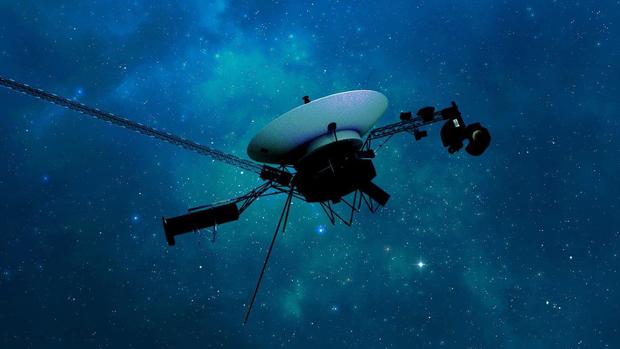
Last month, the craft's engineering team was able to confirm that the issue was related to one of the three onboard computers that make up Voyager 1's flight data subsystem. That system is what packages science and engineering data into a readable format before sending it to Earth. The team determined that "a single chip responsible for storing a portion of the (system's) memory," including some computer software code, wasn't working.
The chip couldn't be repaired and the code was too large to place in one new location, NASA said, so the team worked to relocate the affected code into multiple sections of the flight data subsystem. It took weeks to repackage the code, NASA said, and last Thursday, the new location was communicated to Voyager 1.
It takes about 22 and a half hours for a radio signal to reach Voyager 1 in interstellar space , or the space between stars, NASA said. On Saturday, the spacecraft's mission team received a response, confirming that the code modification had worked.
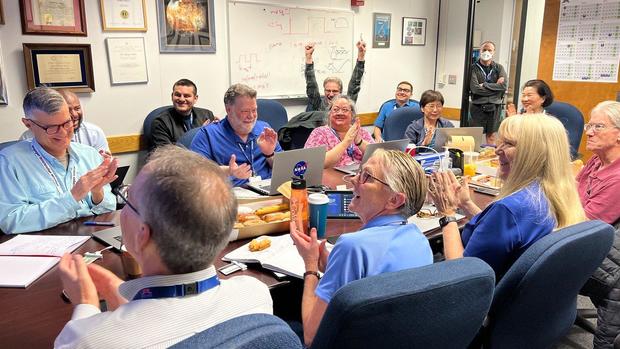
Engineers celebrated receiving new data for the first time in almost half a year, but the work isn't done yet. NASA said that in the coming weeks, the mission team will "relocate and adjust the other affected portions" of the software, including portions that will start returning science data. Meanwhile, Voyager 2 continues to operate with no issues, and both craft will continue to report back on the distant reaches of the solar system.
Kerry Breen is a reporter and news editor at CBSNews.com. A graduate of New York University's Arthur L. Carter School of Journalism, she previously worked at NBC News' TODAY Digital. She covers current events, breaking news and issues including substance use.
More from CBS News

Olympic gold medalist Gabby Douglas competes for first time since 2016

Hamas hostage's niece worries a deal isn't in Netanyahu's "political interest"

Pope Francis makes first trip outside of Rome in seven months

Military families feel betrayed over jet fuel-tainted water at Hawaii base
Inside NASA's 5-month fight to save the Voyager 1 mission in interstellar space

After working for five months to re-establish communication with the farthest-flung human-made object in existence, NASA announced this week that the Voyager 1 probe had finally phoned home.
For the engineers and scientists who work on NASA’s longest-operating mission in space, it was a moment of joy and intense relief.
“That Saturday morning, we all came in, we’re sitting around boxes of doughnuts and waiting for the data to come back from Voyager,” said Linda Spilker, the project scientist for the Voyager 1 mission at NASA’s Jet Propulsion Laboratory in Pasadena, California. “We knew exactly what time it was going to happen, and it got really quiet and everybody just sat there and they’re looking at the screen.”
When at long last the spacecraft returned the agency’s call, Spilker said the room erupted in celebration.
“There were cheers, people raising their hands,” she said. “And a sense of relief, too — that OK, after all this hard work and going from barely being able to have a signal coming from Voyager to being in communication again, that was a tremendous relief and a great feeling.”

The problem with Voyager 1 was first detected in November . At the time, NASA said it was still in contact with the spacecraft and could see that it was receiving signals from Earth. But what was being relayed back to mission controllers — including science data and information about the health of the probe and its various systems — was garbled and unreadable.
That kicked off a monthslong push to identify what had gone wrong and try to save the Voyager 1 mission.
Spilker said she and her colleagues stayed hopeful and optimistic, but the team faced enormous challenges. For one, engineers were trying to troubleshoot a spacecraft traveling in interstellar space , more than 15 billion miles away — the ultimate long-distance call.
“With Voyager 1, it takes 22 1/2 hours to get the signal up and 22 1/2 hours to get the signal back, so we’d get the commands ready, send them up, and then like two days later, you’d get the answer if it had worked or not,” Spilker said.

The team eventually determined that the issue stemmed from one of the spacecraft’s three onboard computers. Spilker said a hardware failure, perhaps as a result of age or because it was hit by radiation, likely messed up a small section of code in the memory of the computer. The glitch meant Voyager 1 was unable to send coherent updates about its health and science observations.
NASA engineers determined that they would not be able to repair the chip where the mangled software is stored. And the bad code was also too large for Voyager 1's computer to store both it and any newly uploaded instructions. Because the technology aboard Voyager 1 dates back to the 1960s and 1970s, the computer’s memory pales in comparison to any modern smartphone. Spilker said it’s roughly equivalent to the amount of memory in an electronic car key.
The team found a workaround, however: They could divide up the code into smaller parts and store them in different areas of the computer’s memory. Then, they could reprogram the section that needed fixing while ensuring that the entire system still worked cohesively.
That was a feat, because the longevity of the Voyager mission means there are no working test beds or simulators here on Earth to test the new bits of code before they are sent to the spacecraft.
“There were three different people looking through line by line of the patch of the code we were going to send up, looking for anything that they had missed,” Spilker said. “And so it was sort of an eyes-only check of the software that we sent up.”
The hard work paid off.
NASA reported the happy development Monday, writing in a post on X : “Sounding a little more like yourself, #Voyager1.” The spacecraft’s own social media account responded , saying, “Hi, it’s me.”
So far, the team has determined that Voyager 1 is healthy and operating normally. Spilker said the probe’s scientific instruments are on and appear to be working, but it will take some time for Voyager 1 to resume sending back science data.
Voyager 1 and its twin, the Voyager 2 probe, each launched in 1977 on missions to study the outer solar system. As it sped through the cosmos, Voyager 1 flew by Jupiter and Saturn, studying the planets’ moons up close and snapping images along the way.
Voyager 2, which is 12.6 billion miles away, had close encounters with Jupiter, Saturn, Uranus and Neptune and continues to operate as normal.
In 2012, Voyager 1 ventured beyond the solar system , becoming the first human-made object to enter interstellar space, or the space between stars. Voyager 2 followed suit in 2018.
Spilker, who first began working on the Voyager missions when she graduated college in 1977, said the missions could last into the 2030s. Eventually, though, the probes will run out of power or their components will simply be too old to continue operating.
Spilker said it will be tough to finally close out the missions someday, but Voyager 1 and 2 will live on as “our silent ambassadors.”
Both probes carry time capsules with them — messages on gold-plated copper disks that are collectively known as The Golden Record . The disks contain images and sounds that represent life on Earth and humanity’s culture, including snippets of music, animal sounds, laughter and recorded greetings in different languages. The idea is for the probes to carry the messages until they are possibly found by spacefarers in the distant future.
“Maybe in 40,000 years or so, they will be getting relatively close to another star,” Spilker said, “and they could be found at that point.”
Denise Chow is a reporter for NBC News Science focused on general science and climate change.
Contact restored with NASA’s Voyager 1 space probe

Contact restored.
That was the message relieved NASA officials shared after the agency regained full contact with the Voyager 1 space probe, the most distant human-made object in the universe, scientists have announced.
For the first time since November, the spacecraft is returning usable data about the health and status of its onboard engineering systems, NASA said in a news release Monday.
The 46-year-old pioneering probe, now 15.1 billion miles from Earth, has continually defied expectations for its life span as it ventures farther into the uncharted territory of the cosmos .
More: Voyager 1 is 15 billion miles from home and broken. Here's how NASA is trying to fix it.
Computer experts to the rescue
It wasn't as easy as hitting Control-Alt-Delete, but top experts at NASA and CalTech were able to fix the balky, ancient computer on board the probe that was causing the communication breakdown – at least for now.
A computer problem aboard Voyager 1 on Nov. 14, 2023, corrupted the stream of science and engineering data the craft sent to Earth, making it unreadable .
Although the radio signal from the spacecraft had never ceased its connection to ground control operators on Earth, that signal had not carried any usable data since November, NASA said. After some serious sleuthing to fix the onboard computer, that changed on April 20, when NASA finally received usable data.
In interstellar space
The probe and its twin, Voyager 2, are the only spacecraft to ever fly in interstellar space (the space between the stars).
Voyager 2 continues to operate normally, NASA reports. Launched more than 46 years ago , the twin spacecraft are standouts on two fronts: they've operated the longest and traveled the farthest of any spacecraft ever.
Before the start of their interstellar exploration, both probes flew by Saturn and Jupiter, and Voyager 2 flew by Uranus and Neptune.
More: NASA gave Voyager 1 a 'poke' amid communication woes. Here's why the response was encouraging.
They were designed to last five years but have become the longest-operating spacecraft in history. Both carry gold-plated copper discs containing sounds and images from Earth, content that was chosen by a team headed by celebrity astronomer Carl Sagan .
For perspective, it was the summer of 1977 when the Voyager probes left Earth. "Star Wars" was No. 1 at the box office, Jimmy Carter was in the first year of his presidency, and Elvis Presley had just died.
Contributing: Eric Lagatta and George Petras

IMAGES
VIDEO
COMMENTS
Galleries of Images Voyager Took. The Voyager 1 and 2 spacecraft explored Jupiter, Saturn, Uranus and Neptune before starting their journey toward interstellar space. Here you'll find some of those iconic images, including "The Pale Blue Dot" - famously described by Carl Sagan - and what are still the only up-close images of Uranus and Neptune.
This photo of Jupiter was taken by NASA's Voyager 1 on the evening of March 1, 1979, from a distance of 2.7 million miles (4.3 million kilometers). ... This illustrated graphic was made to mark Voyager 1's entry into interstellar space in 2012. It puts solar system distances in perspective, with the scale bar in astronomical units and each ...
2012x2994x3. PIA01480: Voyager 2 Launch. Full Resolution: TIFF (17.25 MB) JPEG (444 kB) 2003-05-09. Voyager Interstellar Mission. 3017x2494x3. PIA04495: Artist's Concept of Voyager.
Early Voyager 1 Images of Jupiter Full Resolution: TIFF (491.5 kB) JPEG (21.78 kB) 1996-09-26: Jupiter: Voyager: Imaging Science Subsystem: 400x400x3: PIA00029: First Close-up Image of Jupiter from Voyager ...
Voyager 1 officially entered interstellar space on Aug. 25, 2012, while Voyager 2 entered on Nov. 5, 2018. ... Private space-junk probe snaps historic photo of discarded rocket in orbit. 3.
On Feb. 14, 1990, NASA's Voyager 1 probe snapped a photo of Earth from 3.7 billion miles (6 billion kilometers) away. ... Voyager 1 spacecraft's road to interstellar space: A photo timeline;
Image: NASA / JPL / Ted Stryk. Saturn as seen by Voyager 1 The last picture from Voyager 1's approach to Saturn in which the entire planet and ring system can be seen in a single frame. Image: NASA/JPL/Björn Jónsson. Voyager 2's best view of Enceladus This was the Voyager mission's best view of Enceladus, captured by Voyager 2 on August 26 ...
NASA. This image of the Earth and moon in a single frame, the first of its kind ever taken by a spacecraft, was recorded on Sept. 18, 1977, by Voyager 1 when it was 7.25 million miles from Earth ...
For 33 years, America's Voyager spacecraft have been flying toward the edges of our solar system. TIME surveys the most notable interstellar scenes captured by the Voyager's cameras along the way. PHOTOS: Window on Infinity: Pictures from Space. MORE: Voyager 1 at the Threshold of Forever
Our crescent Earth and moon in the first picture of its kind ever captured by a spacecraft. Taken on Sept. 18, 1977, 7 million miles (12 million km) away from Earth. Voyager 1's closest approach ...
Voyager 2 crossed into interstellar space a year ago. Now, five teams of astronomers have analyzed the data it returned to paint a picture of this boundary in the outer solar system. Four decades after its launch into the outer solar system, Voyager 2 crossed the boundary that separates the Sun's domain from the stuff that floats between the ...
Launched in 1977 to study Jupiter and Saturn, Voyager 1 has been exploring interstellar space — the space between star systems — since 2012. Its twin, Voyager 2, is 12.6 billion miles (20 ...
Launched nearly 47 years ago, Voyager 1 is flying on an outbound trajectory more than 15 billion miles (24 billion kilometers) from Earth, and it takes 22-and-a-half hours for a radio signal to ...
Scientists are hopeful of collecting fresh data from the Voyager 1 deep space probe after it beamed back its first signals in five months.. The pioneering craft, which launched in 1977, was the first to enter interstellar space, the region beyond the solar system.. But Nasa engineers at mission control in California lost contact with it on November 14 due to a fault with one of its three on ...
Voyager 1 Launch Full Resolution: TIFF (10.25 MB) JPEG (249 kB) 2018-10-03: Voyager Interstellar Mission: 1280x720x3: PIA22566: Voyager Probes Heliosphere Chart Full Resolution: TIFF (2.766 MB) JPEG (74.06 kB) 2018-12-10: Voyager Interstellar Mission
Voyager 1 and 2, cruising along diverging paths, made history by crossing the heliopause in 2012 and 2018, respectively (SN: 9/12/13; SN: 12/10/18). At nearly 18 billion kilometers from the sun ...
Voyager 1 is cruising through interstellar space roughly 15 billion miles (24 billion kilometers) away from Earth, which means mission control teams have to wait 22.5 hours for their commands to ...
The Pale Blue Dot is a photograph of Earth taken Feb. 14, 1990, by NASA's Voyager 1 at a distance of 3.7 billion miles (6 billion kilometers) from the Sun. NASA/JPL-Caltech. Voyager 1, meanwhile ...
The probe and its twin, Voyager 2, are the only spacecraft to ever fly in interstellar space (the space between stars). Voyager 1 stopped sending readable science and engineering data back to Earth on Nov. 14, 2023, even though mission controllers could tell the spacecraft was still receiving their commands and otherwise operating normally.
It takes about 22 and a half hours for a radio signal to reach Voyager 1 in interstellar space, or the space between stars, NASA said. On Saturday, the spacecraft's mission team received a ...
In 2012, Voyager 1 ventured beyond the solar system, becoming the first human-made object to enter interstellar space, or the space between stars. Voyager 2 followed suit in 2018. Voyager 2 ...
An artist's illustration depicts Voyager 1 as it travels through interstellar space, or the space between stars. NASA/JPL-Caltech Sign up for CNN's Wonder Theory science newsletter.
Color Voyager 2 Image Showing Crescent Uranus Full Resolution: TIFF (231.9 kB) JPEG (17.76 kB) 1998-06-04: Enceladus: Voyager: VG ISS - Narrow Angle: 1004x1004x3: PIA00347: Voyager 2 Color Image of Enceladus, Almost ...
In interstellar space The probe and its twin, Voyager 2, are the only spacecraft to ever fly in interstellar space (the space between the stars). Voyager 2 continues to operate normally, NASA reports.